Backyard Birds: Invite Entertaining Hummingbirds Into Your Garden
http://www.decor-ideas.org 09/10/2015 21:13 Decor Ideas
Hummingbirds are dazzling jewels in any landscape. You might not know it, but hummingbirds, or hummers, as they are affectionately known, live only in North, Central and South America. What better way to celebrate these delicate beauties unique to the Americas than to learn more about putting your yard to work to support them?
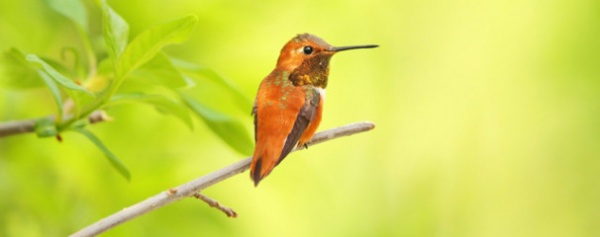
Shown: Male rufous hummingbird
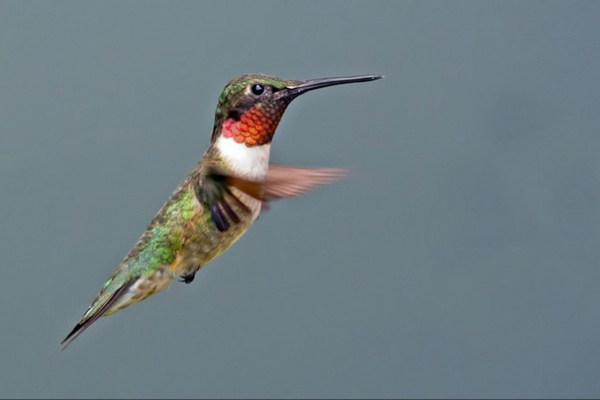
Order: Apodiformes (The name means “without feet,” which is certainly how these birds look most of the time.)
Common names: More than a dozen species of hummingbirds summer in North America; ruby-throated (Archilochus colubris), black-chinned (Archilochus alexandri), Anna’s (Calypte anna) and rufous (Selasphorus rufus) are the most common in yards.
Distribution: If you live in the East, especially toward the North, ruby-throated hummers are the most common, and probably the only, hummingbird you’ll see (male shown here). Species diversity improves west of the Mississippi river, where you’ll spot black-chinned, Anna’s, rufous and at least eight other species.
Habitat: Hummingbirds are found in many kinds of habitats. They are least likely to be found in dense forests and tend to stick to more open landscapes. The ones highlighted here are common in yards in their ranges.
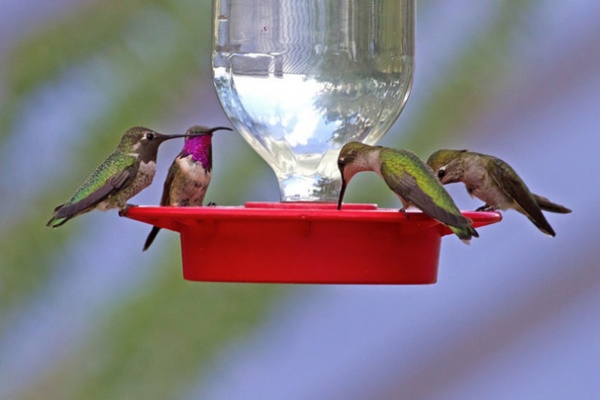
There is an abundance of hummingbirds west of the Mississippi. People living in Texas, New Mexico and Arizona have the most species as potential backyard visitors.
At the feeder pictured here, in Sierra Vista, Arizona, there is, from left, a male black-chinned, a male Lucifer and two female black-chinned hummingbirds. This shot is neat not only because it shows some species diversity, but because male hummingbirds tend to be really territorial, so it is rare to see two males sharing the same feeder.
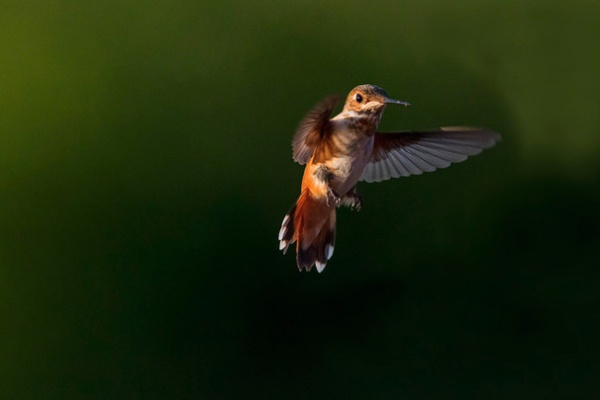
When to look for them. Depending on where you live, hummingbirds are either year-round residents or summer treats.
Hummingbirds, despite their diminutive size, often have extensive migrations. The rufous hummingbird, pictured here, makes one of the longest migration routes of any bird relative to its size. According to All About Birds, “at just over 3 inches long, its roughly 3,900-mile movement (one-way) from Alaska to Mexico is equivalent to 78,470,000 body lengths.”
Their annual routes vary by species and region, and some early data from eBird even suggests that migration routes can change from season to season. The variability may increase as we see shifts in climate that affect seasonal habitat changes and resource availability.
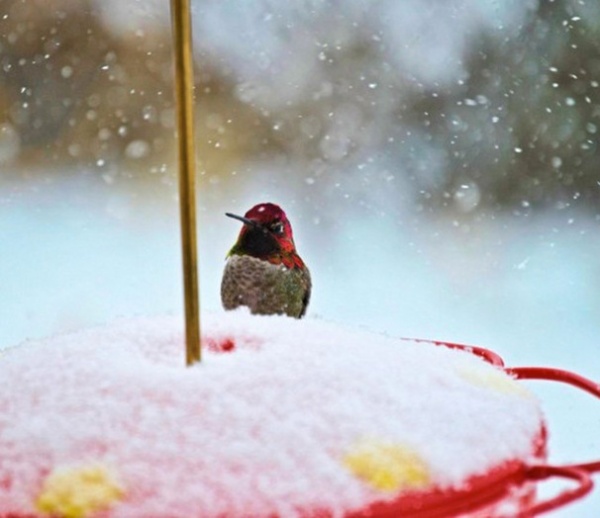
Most hummingbirds retreat south in autumn, but Anna’s hummingbirds are found in northern latitudes throughout the year. Since 1960 they’ve moved their year-round limit north from California to British Columbia. They’re taking advantage of flowering plants and shrubs as well as hummingbird feeders.
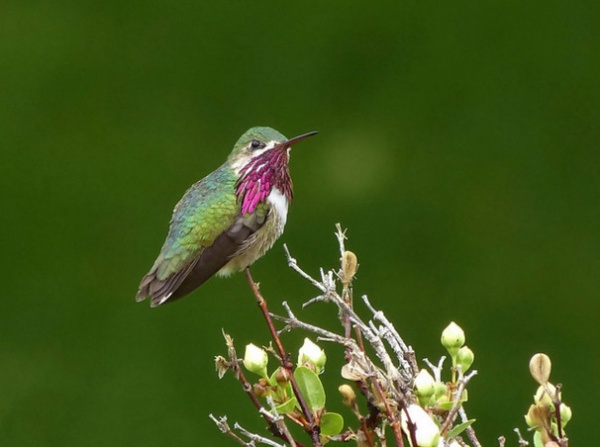
How to spot hummingbirds. These now-you-see-them, now-you-don’t aerial wonders include the smallest bird in North America, the calliope hummingbird (male shown here), measuring on average 3 inches long with a weight of only 0.1 ounce, about what a penny weighs.
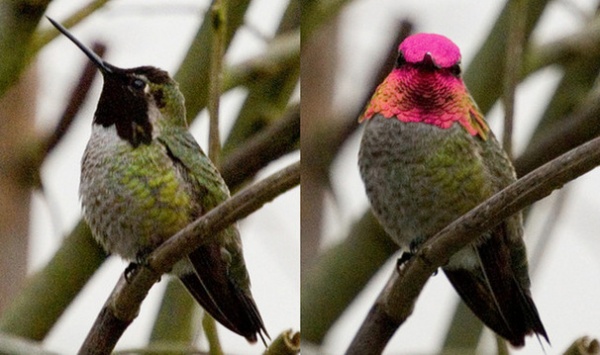
Males of the rufous, Anna’s, ruby-throated and black-chinned species are all more brightly colored than the females. The females are nearly all grayish in color, making it very difficult to distinguish females of different species with overlapping ranges.
The iridescent throat patch of male hummingbirds is called a gorget. The gorget of Anna’s hummingbird, seen here, extends over its head. These two images were taken of the same male Anna’s hummingbird 20 seconds apart, demonstrating how the viewing angle affects the appearance of the iridescent gorget feathers.
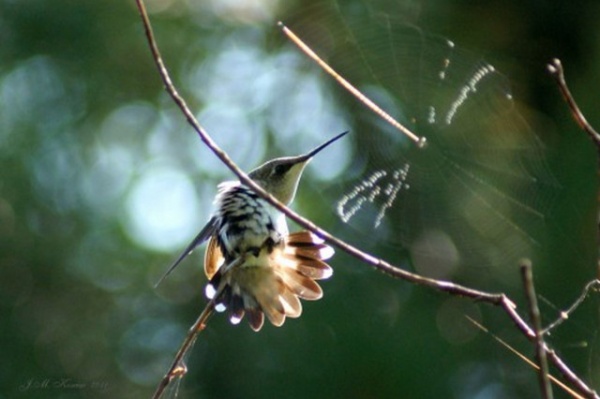
How to Attract Hummingbirds
These tiny but hardy birds rely on nectar as their primary food source, but some species also eat insects. The ruby-throated hummingbird (female shown here) catches insects such as mosquitoes, gnats, fruit flies and small bees in midair or harvests them from spiderwebs. The regular food source of these birds is nectar from native plants specific to the regions in which they forage, breed, migrate and overwinter.
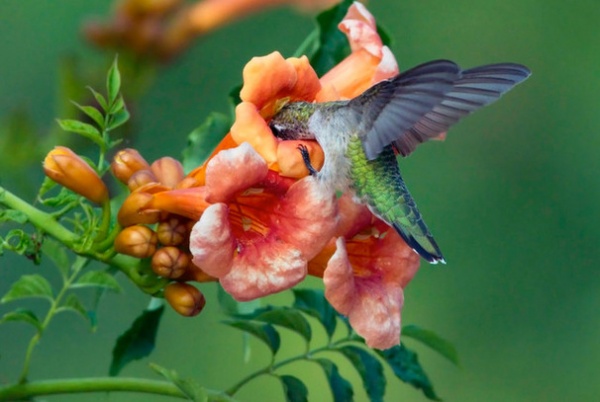
Provide plants they love. Examples of food-source plants that ruby-throated hummingbirds, pictured, find irresistible are wild columbine (Aquilegia canadensis), trumpet creeper (Campsis radicans), wild bergamot (Monarda fistulosa), trumpet honeysuckle (Lonicera sempervirens, shown here) and cardinal flower (Lobelia cardinalis).
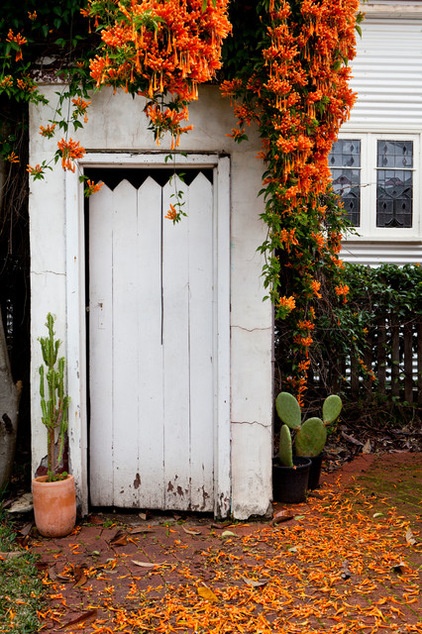
Establishing these perennials in fall, like the trumpet creeper here, will provide hummers with food reserves as they begin their migration south, or it can be a way to get a jump-start on creating habitat for the spring.
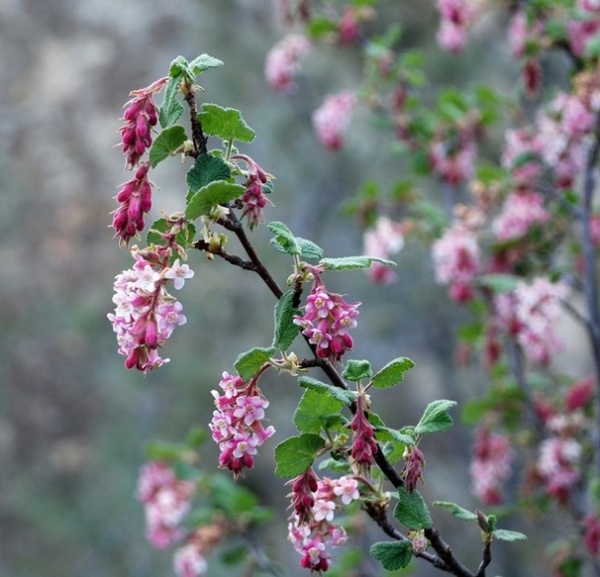
Anna’s hummingbird, common up and down the Pacific Coast, looks for native plants like pink chaparral currant (Ribes malvaceum), canyon gooseberry (Ribes menziesii), manzanita (Arctostaphylos spp.) and some introduced species, such as eucalyptus. They will also hunt insects or consume tree sap. Keeping vibrant gardens filled with native flowering plants that provide nectar and habitat for native insects is crucial for supporting hummingbirds.
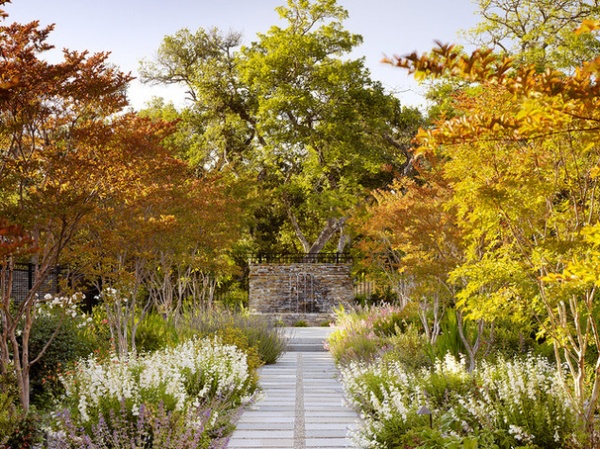
A well-distributed hummer west of the Mississippi is the black-chinned hummingbird, found in a variety of habitats, from deserts to mountain forests. Native plants that attract black-chinned hummingbirds are beardtongue (Penstemon spp., the white flowers pictured here), larkspur (Delphinium spp.), sage (Salvia spp.) and trumpet vines (Campsis spp. and Lonicera spp.). Like other hummers, the black-chinned will often feast on available insects.
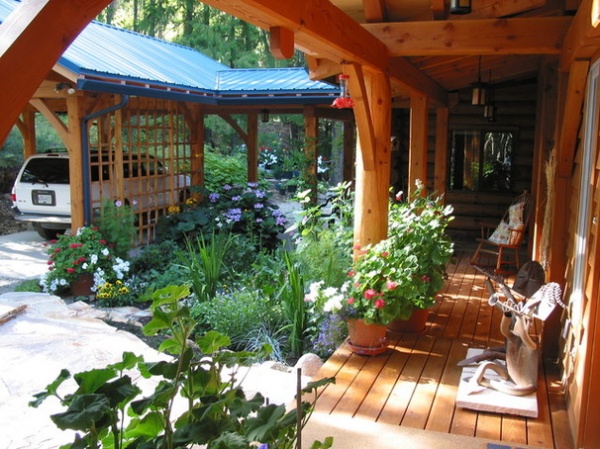
Keep feeders simple, full and clean. Though native gardens are an important food source that supports North American hummingbirds, hummingbird feeders are a common yard feature for bird enthusiasts. These feeders can effectively help to support hummers during their long migrations, can provide resources in early winter and are an excellent option in urban areas that have limited space for gardens. However, take care: There are important strategies to keep in mind when installing and maintaining a hummingbird feeder, as even your best intentions can endanger the safety of the birds.
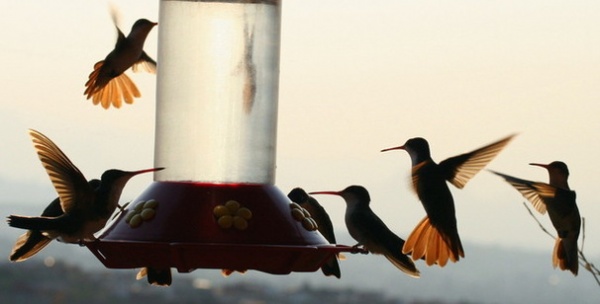
Choose a hummingbird feeder that is simple and easy to clean. The more complicated the long dispenser or other features are, the harder to keep the feeder sterile.
The sugar solution should be an easy homemade mix of ¼ cup of standard white sugar per 1 cup of water. Honey, raw sugar or other forms of sweetener should not be used. Also, do not add red coloring. If you purchase a feeding solution in the store, avoid those that have added ingredients or dyes. This is to minimize the amount of unnecessary additives in hummingbirds’ diets.
Shown: Ruby-throated females
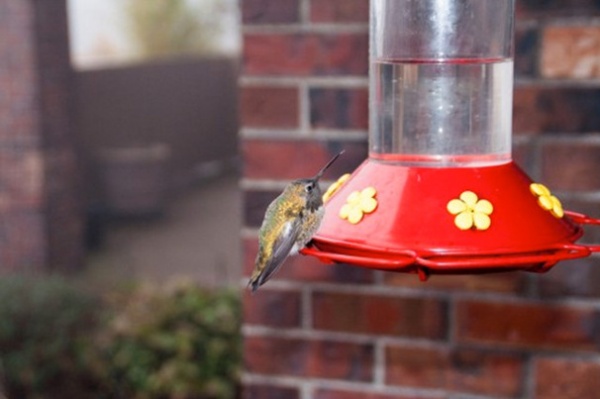
Any bird feeder needs regular cleaning. At the Cornell Lab of Ornithology, we recommend cleaning your feeders at least once a week with hot, soapy water and a good scrub brush. This helps to kill unwanted mold and bacteria. The sugar solution, if it is not entirely consumed in a day, should be changed every two to three days, or once a day in very warm climates or temperatures. This will help minimize the growth of unwanted fermented sugars that can be lethal to hummers.
Following these feeding steps will allow you to provide an excellent supplement to the flowering nectar plants and insects in your garden. If maintenance of the feeder is too involved, it’s better to take the feeder down than neglect changing the solution or avoiding cleaning, as feeders may spread disease.
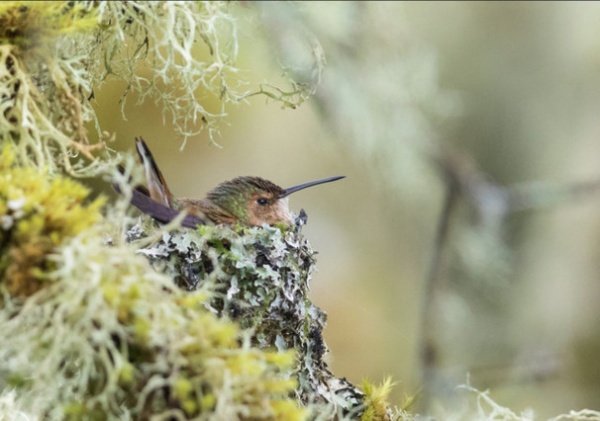
Offer the ideal habitat. Females choose the nest site, usually a horizontal branch of trees or shrubs 6 to 20 feet off the ground (occasionally higher) near a source of nectar. They often build nests on a variety of plants and human-made objects. They use conifers less frequently.
When newly built, the nest is a compact, deep cup constructed of plant down, spider silk, lichens and cocoon fibers. As the nestlings grow, the nest stretches into a wider, shallower cup. Nests in cooler areas are thicker-walled than nests in warmer areas.
Shown: Female rufous on a nest
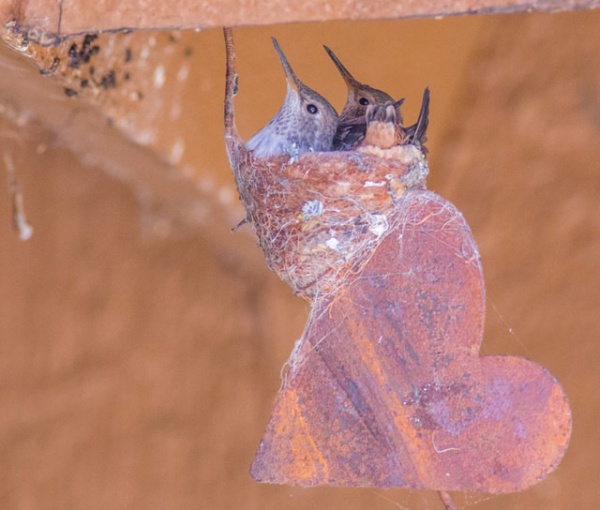
Hummingbirds are dynamic, entertaining visitors to our yards. Provide them with a regionally native flowering habitat, and they will be regular seasonal or year-round visitors. You may even be lucky enough to have your yard chosen as a nesting site and witness the wonder of these tiny birds building their nests out of spiderwebs and lichen in the most precarious places on your property.
YardMap is a citizen science project developed by the Cornell Lab of Ornithology, designed to cultivate a richer understanding of bird habitat, for both professional scientists and people concerned with their local environment. Thousands of people are documenting their conservation efforts at home to support birds and other wildlife in their yards.
More: Create a Container Wildlife Habitat for Hummingbirds and Butterflies
Related Articles Recommended












